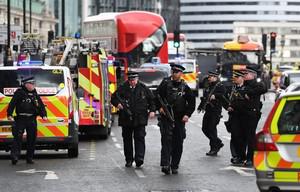London attackLondon attack: Terrorism expert explains three threats of jihadism in the West
In the wake of the 22 March terrorist attack in London, the only certainty, unfortunately, is that this attack will not be the last such attack in the West. As IS loses ground in Iraq and Syria, it will do all it can to retain an ability to strike in the West. While their key aim is to inspire attacks like those in Paris and Brussels, they will be increasingly difficult to conduct. This is due both to its dwindling resources and the increasing readiness of European security agencies who will be learning from recent attacks. Lone actors, while rare, will continue offer IS a cost-free method of attack. Meanwhile, virtual entrepreneurs will be doing all they can to help their Western contacts plot and execute mass killings from afar.

Police lockdown the scene of the recent London attack // Source: theconversation.com
Details about the man who attacked the British Parliament on 22 March, identified by London police as British national Khalid Masood, are still emerging. With four victims confirmed dead, the attack is the worst in London since the July 7, 2005 bombings on the London transport system.
A day after the attack, the Islamic State media organization Amaq released a statement claiming responsibility. The statement read: “The attacker yesterday in front of the British Parliament was a soldier of the Islamic state.”
The language of the statement can help us understand the nature of not just this attack, but the nature of jihadist attacks in the West. Based on ten years of research on the topic, I have identified three categories into which this attack is likely to fall.
Directed attack
The first and least probable scenario is that the attack in London was planned and directed by individuals within the IS hierarchy. In such a situation, the attacker would be part of a wider IS network.
Those types of attacks, such as the ones conducted by IS in Paris and Brussels (the anniversary of which was also on the same day as the London attack) in 2015 and 2016, respectively, are usually deadlier and more sophisticated than what we saw in London. The crude nature of the killings, in which Masood used a car as a battering ram before rushing police officers with knife, suggests that this act falls into one of the two following categories.
Inspired attack
This may have been a so-called “inspired” attack. This refers to a terrorist act undertaken by someone with no known ties to IS or other jihadist groups. These individuals see themselves as part of the wider global jihad movement after consuming jihadist propaganda and interacting with like-minded individuals online. They plan the attack alone, with no input from a terrorist organization.
The last such “inspired” incident in London was the killing of British Army soldier Lee Rigby in May 2013. The attackers, Michael Adebolajo and Michael Adebowale, were inspired by al-Qaida and used a similar tactic to that seen in the Parliament attack, ramming their target with a car before stabbing him repeatedly.
